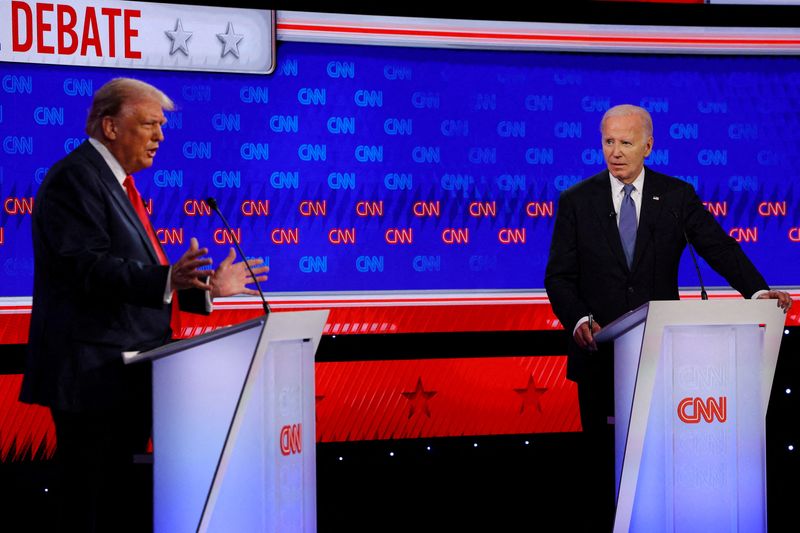By Jamie McGeever
ORLANDO, Florida (Reuters) – If history is any guide, uncertainty surrounding the U.S. presidential election will rise as the November vote draws closer, which would be an additional headwind for an economy already showing signs of losing momentum.
Economic policy uncertainty indexes capturing these trends have not kicked in yet. But assuming they do, the heightened anxiety could herald a softer second half of the year not only for the economy but for Wall Street too.
Much of this year’s stock-market strength has been built on solid earnings growth forecasts. These are likely to be revised if economic growth, consumer spending, corporate investment or hiring cools further.
Institute for Supply Management data this week shows that manufacturing activity shrank in June for a third straight month, and service-sector employment and new orders slumped.
This is the economic landscape four months from a November election that is still expected to fought between frontrunners President Joe Biden and former President Donald Trump, despite the incumbent’s widely-panned TV debate performance last week.
Populism, polarization and an expected tight race produce a perfect storm for a surge in the economic policy uncertainty index, (EPU) a news-headline-based index created in 2016 by economics professors Steven J. Davis, Scott R. Baker and Nick Bloom.
Rising EPU occurs when a muddied outlook for government policy forces consumers to delay spending and businesses to put investment and hiring on ice.
Analysts at Brandywine Global say this may be happening. They note that the University of Michigan’s current economic conditions index is below the expectations index, a rare occurrence that suggests consumers are unusually anxious.
“Our take on this development is that this year’s election cycle, whether warranted or not, is already having an impact on the U.S. consumer and, by default, the corporate sector,” the analysts wrote last week.
SLOW DOWN
Davis, senior fellow at the Hoover Institution and co-founder of the EPU index, said the current level of EPU in the United States is “a bit of a puzzle”, given the fiscal, monetary policy and geopolitical uncertainty already swirling ahead of the election.
“I expect to see more elevated levels of EPU,” in the coming months, Davis said, noting that at the aggregate level, the drag on GDP growth from a somewhat elevated EPU is modest.
“But there are episodes in which high levels of uncertainty can have quite a negative impact and materially amplify recessionary forces,” Davis said.
The U.S. economy is not in recession yet, at least not officially. But the Atlanta Fed’s GDPNow second-quarter tracking estimate has slumped to 1.5% real GDP growth from over 4% in mid-May, and U.S. economic surprises are the most negative in two years.
Davis’ 2016 research found that on a micro level, policy uncertainty is associated with greater stock-price volatility, and reduced investment and employment in policy-sensitive sectors like defense, healthcare, finance and infrastructure construction.
The results at the macro level are less clear-cut, but rising uncertainty tends to foreshadow declines in investment, output, and employment. And EPU usually rises around election time.
RAZOR-THIN MARGINS
In a 2020 follow-up working paper “Elections, Political Polarization, and Economic Uncertainty”, Davis and colleagues found that EPU increases by 18% in the November of a “typical” presidential election. When elections are close – with a winning margin of less than 5% – and polarized, EPU jumps by 28% in the month of the election.
This is backed up by the findings of a 2018 paper “Partisan Conflict and Private Investment” by Marina Azzimonti, a senior economist and research advisor at the Richmond Fed, that suggested a rise in partisan conflict in Washington can reduce corporate investment by as much as 27%.
High levels of partisan conflict in the U.S. can also slow foreign direct investment. Studying data over a 30-year period from 1985 to 2016, Azzimonti estimates that a 10% rise in her “trade partisan conflict index” corresponded with a 7% decline in FDI from the mean.
The recent market ructions in Mexico, India and France are stark reminders to investors that they underestimate or ignore political risk at their peril. There are signs that the U.S. bond market is beginning to price in a Trump victory and the tax-cutting largesse that might entail.
U.S. betting markets have swung heavily in favor of Trump in the wake of last week’s TV debate. But there is a long way to go, and the last two elections show how thin the margins of victory and defeat can be.
Although nearly a quarter of a billion people are eligible to vote in November, it’s worth remembering that in 2016 Hillary Clinton lost Pennsylvania, Michigan and Wisconsin by just 77,000 votes, and in 2020 Joe Biden defeated Donald Trump by only 44,000 votes in Wisconsin, Arizona and Georgia.

With the outcome potentially resting on razor-thin margins in a handful of states, there is plenty of scope for a higher EPU in the coming months. And if growth is already waning, markets could be in for a rocky ride.
(The opinions expressed here are those of the author, a columnist for Reuters.)
(By Jamie McGeever; Editing by Rod Nickel)
>>> Read full article>>>
Copyright for syndicated content belongs to the linked Source : Investing.com – https://www.investing.com/news/economy-news/columnus-election-uncertainty-and-slowdown–a-heady-mix-for-markets-mcgeever-3507618






























